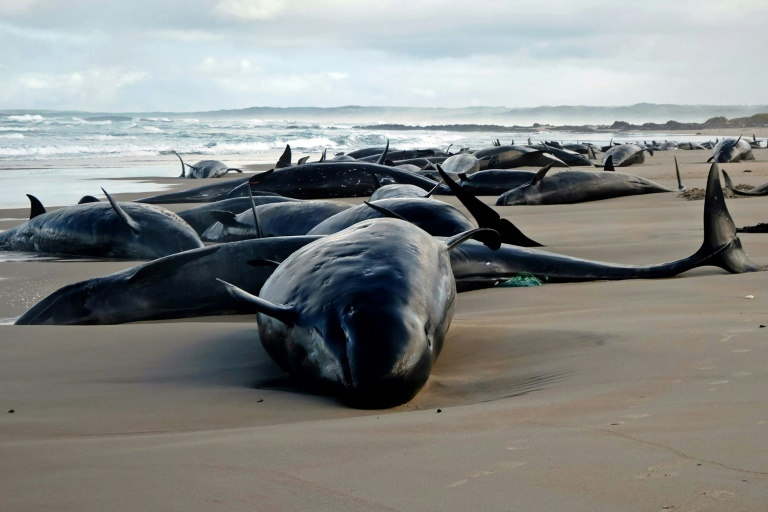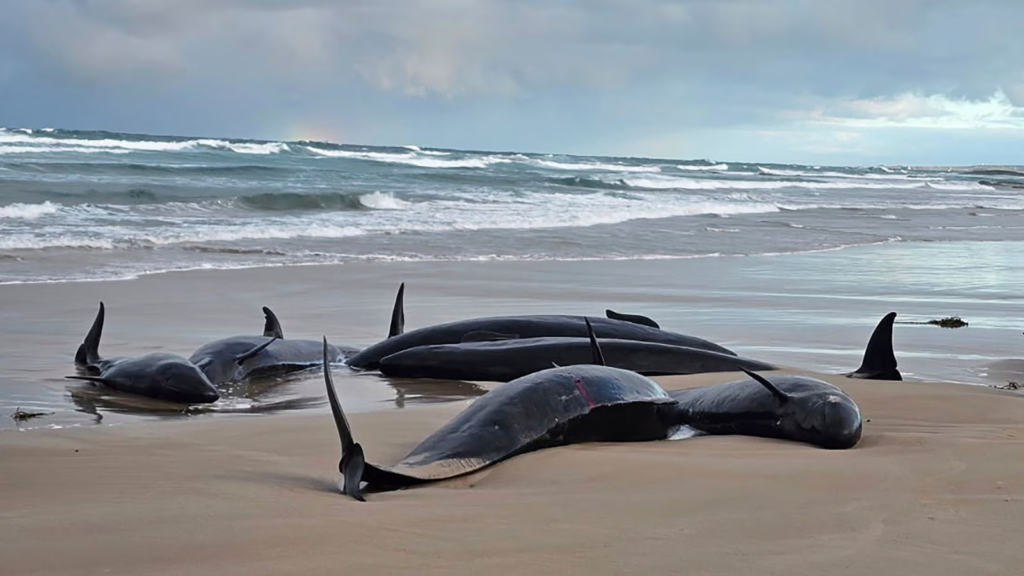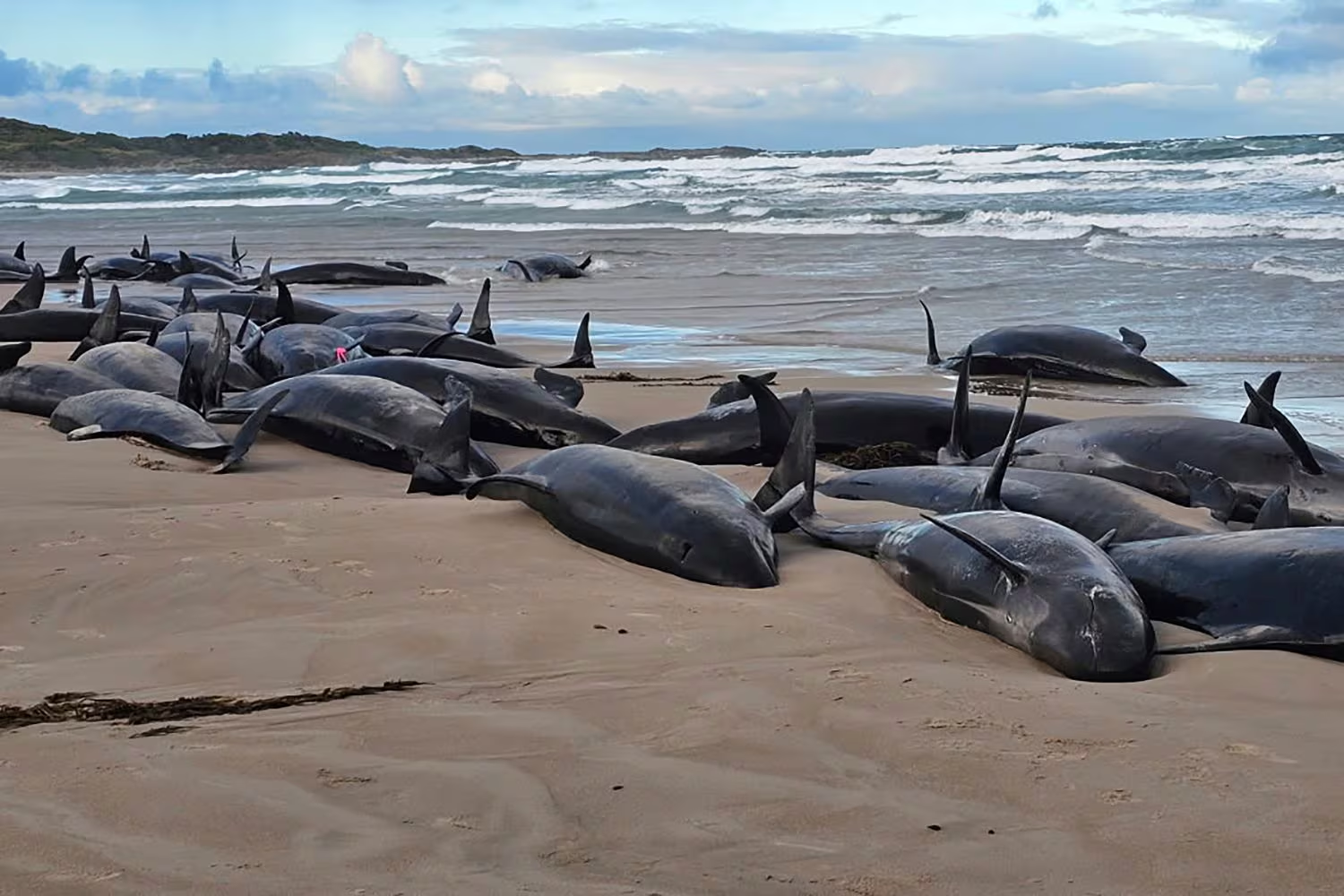Over 150 Dolphins Stranded on Australian Beach has drawn attention to the mysterious and heartbreaking phenomenon of mass strandings.
Despite extensive efforts to refloat the surviving dolphins, wildlife officials have made the painful decision to euthanize 90 of them due to their deteriorating condition and extreme stress. This event underscores the urgent need for further research into why such strandings occur and how they can be prevented in the future.
Dolphins Stranded on Australian Beach
On Tuesday evening, a pod of 157 dolphins was discovered stranded on a remote beach near the Arthur River inlet on Tasmania’s rugged west coast. These dolphins, identified as false killer whales, belong to a poorly understood deep-sea species that is rarely seen near the shore.
By Wednesday afternoon, only 90 of the stranded dolphins were still alive, but they were struggling against exposure to the harsh coastal elements, including scorching sun and strong winds.
Tasmania’s environment department confirmed that the surviving dolphins were showing signs of severe stress and exhaustion. Wildlife rangers and marine rescue teams initially attempted to refloat the dolphins, but their efforts proved largely unsuccessful.
Biologist Kris Carlyon, who has worked on strandings in Tasmania for 16 years, described the location as one of the most challenging he had ever encountered, making rescue operations even more difficult.
Read : Humpback Whale Gulps 24-year-old Kayaker then Spits Him Out in Bahia El Aguila
“This is possibly the trickiest location I’ve seen in 16 years of doing this in Tasmania,” Carlyon said. “It is extremely remote, extremely difficult to get access.”
WATCH: More than 150 false killer whales have been stranded on an isolated beach in the Australian state of Tasmania, with rescue crews trying to save the majority of the large dolphins which resemble killer whales, that survived the ordeal, authorities said on Wednesday,… pic.twitter.com/EqlnQQ6PaW
— GMA Integrated News (@gmanews) February 20, 2025
The dolphins, weighing up to a tonne each, were struggling in the wet sand, with the shallow tide offering little relief. Experts knew that time was running out, as stranded marine mammals quickly succumb to dehydration, organ failure, and predation in such conditions.
The Decision to Euthanize: A Difficult but Necessary Action
After assessing the condition of the remaining 90 dolphins, wildlife officials determined that euthanasia was the most humane course of action. Incident controller Shelley Graham confirmed the difficult decision, stating, “Following expert veterinary assessment, we have made the decision to euthanize the animals. That’s likely to be the course of action for all 90.”
Euthanizing such large marine animals is a complex and heartbreaking task. Carlyon explained that carrying out the procedure safely and humanely requires careful planning. “Euthanasia of an animal this size, it’s not a simple exercise,” he said.
False killer whales are known for their strong social bonds, which often contribute to mass strandings. Scientists speculate that one disoriented or sick individual may have led the entire pod to the shore, triggering the catastrophic event. Such strandings are not uncommon in Australia, but this particular incident was the first of its kind in this region of Tasmania in 50 years.

The decision to euthanize the surviving dolphins has sparked mixed reactions among conservationists and the public. While some understand the necessity of preventing further suffering, others question whether more could have been done to save them. However, marine rescue experts emphasize that attempting further refloating efforts could have prolonged the animals’ distress without a high chance of success.
The Mystery of Mass Strandings and the Need for Research
The reasons behind mass strandings remain largely unknown, although various theories have been proposed. Marine scientist Vanessa Pirotta highlighted the urgency of understanding these events, stating, “The moment a whale or dolphin strands, the clock of survival starts ticking. We don’t yet understand why whales and dolphins strand.”
One theory suggests that Tasmania’s geographical location makes it a hotspot for such incidents. The region’s shallow coastal waters, combined with strong tides and complex underwater topography, may disorient large marine mammals and lead them to shore. Other factors such as environmental changes, disease, and human activities like naval sonar use have also been suggested as possible triggers for strandings.
False killer whales, which can grow up to six meters (20 feet) in length and weigh over a tonne, are particularly vulnerable to mass strandings due to their highly social nature. They often travel in pods of 50 or more, and when one individual encounters trouble, the entire group may follow. This behavior has been observed in multiple stranding events worldwide.
According to the Australian Museum, mass strandings involving false killer whales can wipe out entire schools, affecting hundreds of animals at a time. Despite their size and intelligence, little is known about their population numbers, migratory patterns, or key threats. The Australian government currently lists the species as “near threatened.”

This incident in Tasmania serves as a stark reminder of the fragile balance marine mammals must navigate in their ocean environment. With increasing climate change effects, pollution, and human activities impacting the seas, understanding and mitigating mass strandings should be a priority for marine conservation efforts.
In the wake of this tragedy, experts call for increased investment in marine research, including tracking false killer whale populations and studying their behavior in deeper waters.
Advances in technology, such as satellite tagging and acoustic monitoring, could provide crucial insights into their movements and help prevent future strandings.
As the surviving dolphins are euthanized, questions remain about how to handle similar incidents in the future. While the exact cause of this mass stranding may never be determined, the need for proactive conservation measures and deeper scientific inquiry is clearer than ever.
The dolphins stranded on the Australian beach have captured global attention, evoking sorrow and frustration among those who strive to protect marine life.
Whether driven by natural instincts, environmental shifts, or human interference, such events highlight the delicate relationship between marine species and their changing world. With ongoing research and conservation efforts, the hope remains that future strandings can be better understood—and perhaps even prevented.
let’s enjoy few years on earth with peace and happiness….✍🏼🙏

